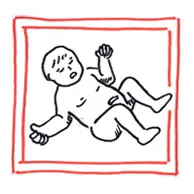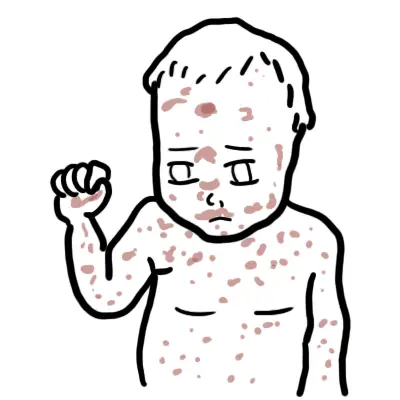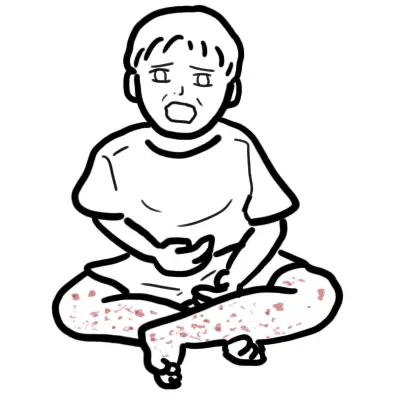Overview
Bronchiolitis is often a viral cause mainly Respiratory Syncytial Virus (RSV). Bronchiolitis is the most common respiratory tract infection of neonates and is usually self-limiting. A major source of confusion of treatment is differentiating a viral bronchiolitis to asthma. In summary bronchiolitis is usually seen in infants <2yo. Asthma is seen in older children.
| Watch: Bronchiolitis Overview |
Respiratory Physiology
| Watch Mechanism of respiration |
Aetiology and Risk Factors
Aetiology
Winter Respiratory Syncytial Virus (RSV)
Others
- Mycoplasma
- Parainfluenza
- Adenovirus
Risk Factors
Risk factors for severe bronchiolitis
- Young, especially < 6weeks
- Ex-premature infants
- Congenital Heart disease
- Neurological conditions
- Chronic respiratory illness
- Pulmonary hypertension
| Side note Exclusive breastfeeding for at least 6 months is recommended to decrease the morbidity of respiratory infections. |
Pathophysiology
An RSV infection begins with replication of the virus in the nasopharynx. The virus spreads to the small bronchiolar epithelium lining the small airways within the lungs, and a lower respiratory tract infection can begin in one to three days. If a lower respiratory tract infection occurs, it causes edema, increased mucus production, and eventual necrosis and regeneration of these epithelial cells. This leads to small airway obstruction, air trapping, and increased airway resistance.
Clinical Manifestation
- Nasal obstruction +/- rhinorrhea
- Apnoea
- Irritating cough
- Tachypnoea
- Respiratory distress
- Fever
- Poor feeding
Examination
- Auscultation (variable): fine inspiratory crackles, expiratory wheeze
- Fever
- Decreased oxygen saturation
- Signs of dehydration
Diagnosis Clinical Diagnosis
Clinical Presentation Nasal obstruction +/- rhinorrhea and an irritating cough are usually noticed first. After one to three days there follows increasing tachypnoea and respiratory distress. The chest is often overexpanded.
Diagnosis
- Acute asthma, associated with viral LRTI
- Pneumonia
- Congestive heart failure
- Pertussis
- Pneumothorax
- Bronchial foreign body
Investigations
In most children with bronchiolitis no investigations are required unless severe.
- PCR for RSV
- Chest X-Ray - hyperinflation
- Blood gases - Oxygen status
- Full Blood Count - signs of infection
Classification
Mild bronchiolitis
- Manage at home
- little or no respiratory distress
- SaO2 >95%
Moderate bronchiolitis
- admit to hospital
- Increased work of breathing, chest wall retraction, nasal flaring
- Decreased feeding
- SaO2 90-95%
Severe bronchiolitis
- Usually require transfer to a tertiary paediatric ICU
- Moderate to serve respiratory distress, with marked chest wall retraction, nasal flaring and grunting
- Very poor feeding, feeding may worsen the cough, tachycardia
- SaO2 >90% room air, or <92 with O2 therapy
High Risk Group
- Infants with chronic lung disease
- infants with congenital heart disease
- Premature or low-weight for gestation age
- Full-term infants up to three months of age
Treatment
Oxygen if saturation drops to 95%
Mild bronchiolitis
- Manage at home
- little or no respiratory distress
- SaO2 >95%
Moderate bronchiolitis
- admit to hospital
- Increased work of breathing, chest wall retraction, nasal flaring
- Decreased feeding
- SaO2 90-95%
Severe bronchiolitis
- Usually require transfer to a tertiary paediatric ICU
- Moderate to serve respiratory distress, with marked chest wall retraction, nasal flaring and grunting
- Very poor feeding, feeding may worsen the cough, tachycardia
Fluids
- Oral feeding OR
- Nasogastric tube for infants with poor feeding OR
- Intravenous fluids if previous do not work and if infant have severe bronchiolitis
Pharmacological Therapy
- Generally no bronchodilators <6months of age
- Corticosteroids or ipratropium only in older infants, if asthma is considered, or infants with chronic lung disease
- Antibiotics if bacterial cause is suspected
| Remember Bronchodilators (albuterol, salbutamol), epinephrine, and corticosteroids are generally not administered to infants and children with the diagnosis of bronchiolitis. Only if another condition is suspected or person is not getting better. |
Discharge
- Minimal respiratory distress
- During the recovery phase, SaO2 92 or above room air
- Provide education, support and follow up with GP
Complication and Prognosis
Complications
- Most resolve without complications
- Dehydration - fluid needs, oral intake, vomiting
- Apnoea – particularly in infants born prematurely & those <2/12, risk for respiratory failure & need for mechanical ventilation
- Secondary bacterial infection
Prognosis
40 percent of children with bronchiolitis will develop further wheezing episodes through five years of age, and 10 percent will have wheezing episodes beyond this age.
















